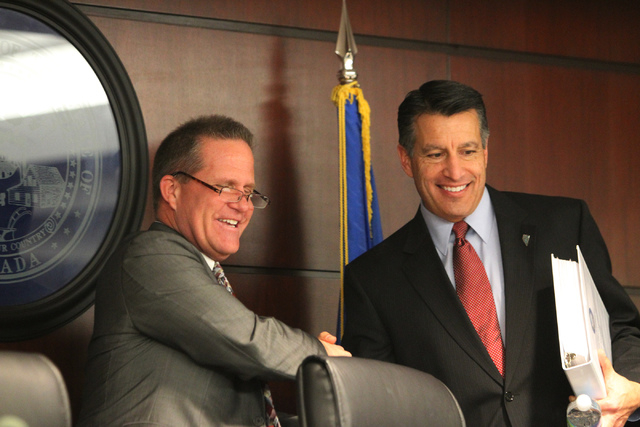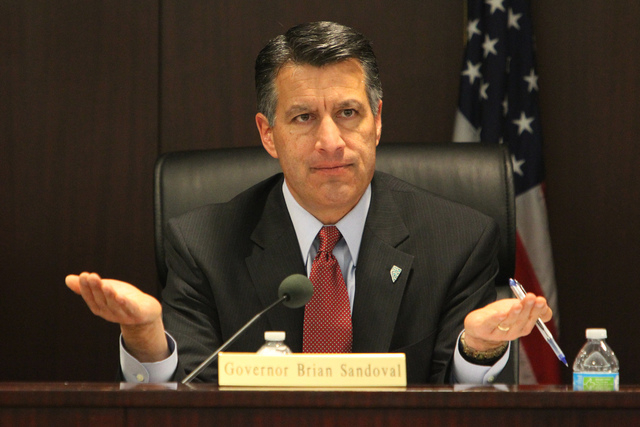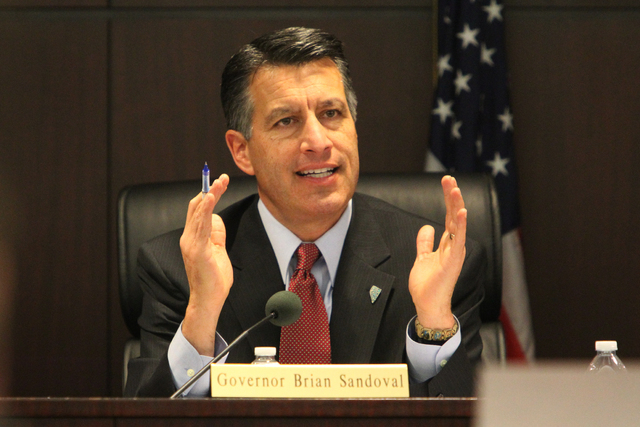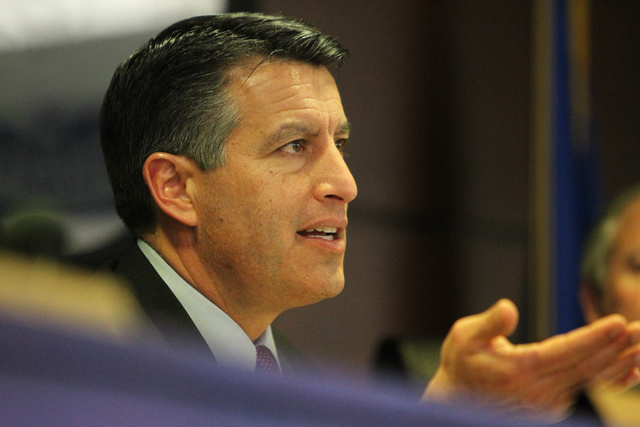Bold education tax plan is make it or break it for Sandoval’s political future
Close your eyes and you might have thought a Democratic governor was delivering the State of the State address to the Nevada Legislature. But that was Republican Brian Sandoval proposing $1.15 billion in new and extended taxes over the next two years, including a business license fee pegged to gross receipts, to boost education spending.
“I never imagined the day when a Republican governor would be proposing things I’d been fighting for all this time,” state Sen. Mo Denis, D-Las Vegas, said after Sandoval’s Jan. 15 address in Carson City ahead of the Legislature’s 120-day session, which begins Monday.
It seems Sandoval is prepared to gamble much of his political capital on a plan to drag Nevada into the future after 150 years of modest goals, tight spending and reliance on gaming and tourism to provide the basic needs of hardy Nevadans and a school system whose graduation rate is one of the worst in the nation.
The question now: Can he succeed, and at what cost to his own political future in the Silver State, in the U.S. Senate, in a presidential Cabinet or even on the U.S. Supreme Court?
“It sounds like he’s decided to go big,” said Jennifer Duffy, an analyst who watches governors across the nation for The Cook Political Report.
NO SMALL PLANS
Nevada’s dismal, overcrowded K-12 school system has been a drag on the state for decades as governor after governor and Legislature after Legislature failed to either advance major reforms or spend big in hopes of showing better results.
Over the next two years, Sandoval wants to boost K-12 spending by $782 million and institute major reforms. His biennial budget includes money for programs such as all-day kindergarten, English-language learning, zoom schools for disadvantaged children, an initiative to have children read by third grade or be held back, and professional development and performance pay for teachers. His goal is to offer students more choice and more help.
Sandoval “gets some points for being the guy who says it’s time to do something,” Duffy said. “Even if you fail, you move the ball down the field a bit toward succeeding. My hunch is a bunch of other governors are watching him pretty closely.”
At least half a dozen other GOP governors are proposing higher taxes, but most Republican leaders tend toward hold-the-line spending and tax cuts. The Republican base, in Nevada and elsewhere, generally wants to cut taxes.
In fact, about a dozen staunch conservatives, including new Republican Assembly members who pledged not to raise taxes, already are vowing to fight what would be the largest tax increase in state history.
Yet Sandoval’s proposal has a higher chance of passage than ever before. There’s bipartisan support for education, and Republicans in the Nov. 4 election gained enough seats to take control of both the state Senate and Assembly. It’s not a clear field, though. About half of the 25 Assembly Republicans are tax-shy conservatives. Sandoval might need the votes of all 17 Democrats in the lower house to get the 28-vote supermajority needed to approve taxes. Fifteen “no” votes would kill or block any tax plan.
Sandoval’s chances appear better in the state Senate, where Republicans hold a slim 11-10 majority, and he needs 14 votes to pass taxes. Still, at least three conservative Republicans appear poised to oppose any tax increase, favoring reforms and cuts instead.
Even if Sandoval wins in the Legislature, he could lose in the short term. It might take years to see if increased education investment pays off, making it difficult to claim major results if Sandoval’s aim is to play in the big leagues of American politics.
A former state attorney general and federal judge, Sandoval gave up a lifetime appointment to run for governor in 2010 and was re-elected last year with more than 70 percent of the vote. His approval ratings routinely poll around 60 percent.
His bold plan could cut into that support.
“If you’ve got this legislative agenda, regardless of why you’re doing it, it makes it hard to run for the Senate,” Duffy said, referring both to criticism for raising taxes and Sandoval’s need to raise lots of hard cash if he runs for the U.S. Senate in 2016.
Sandoval repeatedly has insisted he does not plan to challenge U.S. Sen. Harry Reid, D-Nev., in 2016, despite pressure from those in the Republican Party who see Nevada’s first Hispanic governor as their best hope to defeat the five-term senator.
He also has been mentioned as a potential vice presidential prospect, although his pro-abortion rights stance could be a spoiler for the GOP’s hard right if he runs for that job or even makes a presidential bid. It seems more likely he would seek a Cabinet post in a Republican administration or go back to the bench.
In any event, a successful education finance and reform campaign would enhance Sandoval’s stature on the national scene. There’s a lot riding on his powers of persuasion and negotiating skill.
Robert Uithoven, a GOP operative for former Gov. Jim Gibbons, sees Sandoval as trying to make his mark as governor — one with more elections in his future.
“Four years ago, we heard Gov. Sandoval speak of ambitious goals to create 50,000 jobs by the end of his first term,” Uithoven said. “Now, we hear him speaking not about four-year goals, but 50-year goals.”
“I think just about anyone outside Gov. Sandoval’s closest family and friends who are predicting his next move are just guessing,” he added. “He holds his cards close to the vest and demonstrates an intense focus on the job at hand. And unlike Kenny Guinn, who never showed a desire to seek an elected position after serving as governor, my guess is that we haven’t seen our last ballot with Brian Sandoval’s name on it.”
The main downside if Sandoval fails could come at the ballot box or in tarnishing his political brand.
GETTING TO YES ON TAXES
In 2003, Guinn proposed a record $1 billion tax increase for education. He, too, pushed for a gross receipts business tax in what, ultimately, was a failed effort after legislative and court battles.
Gross receipts taxes haven’t gained popularity in the intervening years. Just last fall, 79 percent of voters rejected one such tax plan that was backed by teachers unions.
In light of those defeats a decade apart, it might be difficult for Sandoval to sell his proposed business license fee increase, which also would take into account gross receipts.
“I’m going to work hard to get this done and make my case,” Sandoval said Friday in an interview with the Las Vegas Review-Journal editorial board.
Although the business community, including gaming, mining, retail interests and the Las Vegas Metro Chamber of Commerce, pledged this year to support higher taxes for education, the governor’s plan is already getting push-back. That might not bode well for his revenue-raising goals.
“The governor’s going to have to spend some time explaining to voters how this is different (from the ballot measure) they rejected,” said Bryan Watcher, Retail Association of Nevada’s director of public and government affairs. “We spent the last 18 months saying this is not the right tax for Nevada, so we do disagree with the mechanism for raising revenue.”
Most business groups have said they would prefer using the Modified Business Tax — a payroll tax — to raise more revenue, as suggested by one outside group, the Tax Foundation.
The rate for most companies is 1.17 percent and for financial institutions 2 percent. Sandoval suggested the mining industry also pay the 2 percent rate while the Tax Foundation suggested expanding it to all Nevada businesses to make it as broad, stable and fair as possible.
One longtime lobbyist predicted that in the end the Legislature might approve some sort of hybrid revenue-raising plan that might involve both the business license fee and the payroll tax.
In his State of the State, Sandoval left the door wide open for discussion, saying with a wry smile, “I know this approach will cause debate.”
“You will all find that there is no perfect solution,” Sandoval said. “What we must all agree on is that another generation of young Nevadans cannot move through our schools without more resources, choice and reform — and that we must modernize our revenue system.”
His message — and his political fortunes — likely will depend on his ability to forge a bipartisan deal that sidesteps some of his fellow Republicans.
Conservatives, led by Assemblywoman Michele Fiore, R-Las Vegas, flatly reject Sandoval’s plans to raise new revenue and extend a package of tax hikes that have been extended twice before, in 2011 and 2013.
Critics note Sandoval ran for governor in 2010 on a promise not to raise taxes and say the extension violated that pledge.
On the state Senate side, Sandoval has the full support of Majority Leader Michael Roberson, R-Las Vegas, while several more conservative Republicans say they don’t see a need to raise revenue and would prefer belt-tightening.
“Any type of gross receipts tax is going to be an uphill battle,” said state Sen. Pete Goicoechea, R-Eureka, who doesn’t back Sandoval’s plan. “There are some worthwhile education programs the governor brought forward, but whether it can be done or not, I don’t know.”
State Sen. Don Gustavson, R-Sparks, said he doesn’t think it’s the right time to raise taxes, while the economy is still recovering.
“I’m not 100 percent opposed to tax increases, but I’m pretty close to it,” Gustavson said. “My top priority will be to hold the line on tax increases.”
Gustavson was one of the “mean 15” Assembly Republicans who blocked Guinn’s $1 billion plan to raise taxes, although the higher levy was backed by the gaming industry.
“I think we may get to 15 this time, too,” Gustavson said.
REACHING OUT, TAKING A CHANCE
Democratic leaders might like what Sandoval is saying, but they aren’t expected to give him a free ride, either.
State Senate Minority Leader Aaron Ford, D-Las Vegas, said he envisions Democrats putting forward a competing tax plan, likely early in the session, although he had no specific time frame. He said “everything is on the table,” including extending sales taxes to services, something Sandoval said he wants to study first.
State Sen. Patricia Spearman, D-North Las Vegas, is taking the lead on some of the revenue issues, Ford said.
“The bottom line for us is we want to make certain it is fair, sustainable and stable over the long term,” Ford said of any tax increase. “We want to make certain it’s broad-based and not put it on the backs of small business. … We’re not going to limit ourselves to a single, sole idea. We intend to vet any and every plan out there.”
Ford called the business license fee increase “an intriguing plan” but would not say if he would vote for it.
“There’s no question the governor has certainly embraced Democratic priorities,” Ford said. “The question is how is he going to corral his Republicans? It’s his party. It’s incumbent on him to try and get some of these ideas funded.”
Assemblywoman Marilyn Kirkpatrick, D-North Las Vegas, has long worked to extend the live entertainment tax to major outdoor events, including NASCAR, Burning Man and the Electric Daisy Carnival. She calls it a “luxury tax” since services often involve using disposable income.
Also, Kirkpatrick said she wants to change the commercial property tax assessments so they’re done more frequently as prices rise, adding that she has no intention of raising property taxes on residents.
“I look forward to working with the governor,” Kirkpatrick said, adding the “devil is in the details” when it comes to tax reform.
“I think every legislator should come to the session with an open mind … There will be angst, but we have a job to do. I think it’s great that the governor is driving the train and leading on this.”
David Damore, a political science professor at the University of Nevada, Las Vegas, said Sandoval could have been bolder in proposing a major overhaul of the state tax system but pulled his punches.
“He punted on real tax reform and instead is pushing a package that he might be able to get through — the sweet spot between the business community and the very small space he has to cut deals with the Dems and the Assembly (Republicans) that get him to 28 and 14,” Damore said. “It will be interesting to see, now that the Dems do not have agenda control, if they come up with an actual revenue plan. Their inaction on both revenue and education created the opening for Sandoval to position himself essentially as a moderate Democrat.”
The 2015 session might be Sandoval’s best chance to make historical changes in both education spending and taxation. He has one more session left, in 2017, but Republicans are expected to lose control of the Assembly in the 2016 presidential election year, and the GOP might have a tough time keeping the state Senate, too. It all depends on the strength of each party’s presidential contenders and political machines.
Sandoval only can serve two four-year terms as governor under current law. And so he will be facing decisions about his future as well.
His fate could be affected by things outside his control. The Nov. 4 election opened a window by putting Republicans in charge of both legislative houses and all constitutional offices for the first time since 1929. But the moderate governor is surrounded by far more conservative state constitutional officers who already are making waves that could hurt his political brand.
Attorney General Adam Laxalt last week joined 25 states in a lawsuit against President Barack Obama over executive actions he has taken on immigration. Laxalt said Obama overreached and was violating the rule of law in going around Congress.
Sandoval also had criticized Obama on the issue but had said he didn’t think a legal fight was the way to go. The governor can’t afford to upset Hispanics, who account for 27 percent of Nevada’s population and who have become a political force at the ballot box, accounting for as much as 18 percent of the vote in the 2012 presidential election.
Secretary of State Barbara Cegavske, meanwhile, is working to get lawmakers to pass a voter ID law. Sandoval has approved of such ideas in the past but is apparently leery of a plan that might be seen as too restrictive or an unnecessary burden on voters.
Democrats have attacked Sandoval, trying to tie him to the actions of his more conservative colleagues. Duffy said most voters will make the distinction between what the governor does and what his Cabinet does.
“They weren’t his choices,” she said, although Sandoval did endorse the Republicans during their campaigns. “He didn’t nominate them. He didn’t appoint them. He can also decide sometimes to distance himself.”
Regardless, Zach Hudson, spokesman for the Nevada Democratic Party, is using a #MeetTheSweep hashtag on Twitter when he slams Republicans swept into office with the help of Sandoval’s popularity.
“Tell @GovSandoval to stop his Trainwreck and stand up for Nevada immigrants,” Hudson tweeted Wednesday in the latest broadside making Sandoval the Democrats’ central target.
The governor, a personable leader, seems to be taking the hits in stride and isn’t backing down one bit.
“The governor laid out a clear vision for a new Nevada in his State of the State address,” spokeswoman Mari St. Martin told the Review-Journal. “Our revenue structure and the way we fund education no longer meet the demands of our growing state. The governor looks forward to an honest conversation with members of the Legislature and the business community.”
As for new funding sources, she added: “The modified business license fee is central to reforming and funding his education plan. We anticipate that several revenue plans will be thoroughly vetted this legislative session. The governor’s proposal is a broad-based, fair and sensible solution that when fully introduced will garner support from legislators and members of the business community who realize what’s at stake for Nevada families.”
And for Sandoval himself.
Contact Laura Myers at lmyers@reviewjournal.com or 702-387-2919. Find her on Twitter: @lmyerslvrj.

RELATED STORIES
Who will speak for business on education?
Gov. Sandoval details new business fee plan to fund Nevada education reform
School choice supporters rally at Nevada Capitol
School crowding top issue for district superintendent
CCSD goals align with most of governor’s proposed education plans
Smoking kills, but it also funds education in Nevada
Sandoval’s education improvement plans draw praise, concerns
New year could bring big changes in state
See all of our coverage: 2015 Nevada Legislature.





















